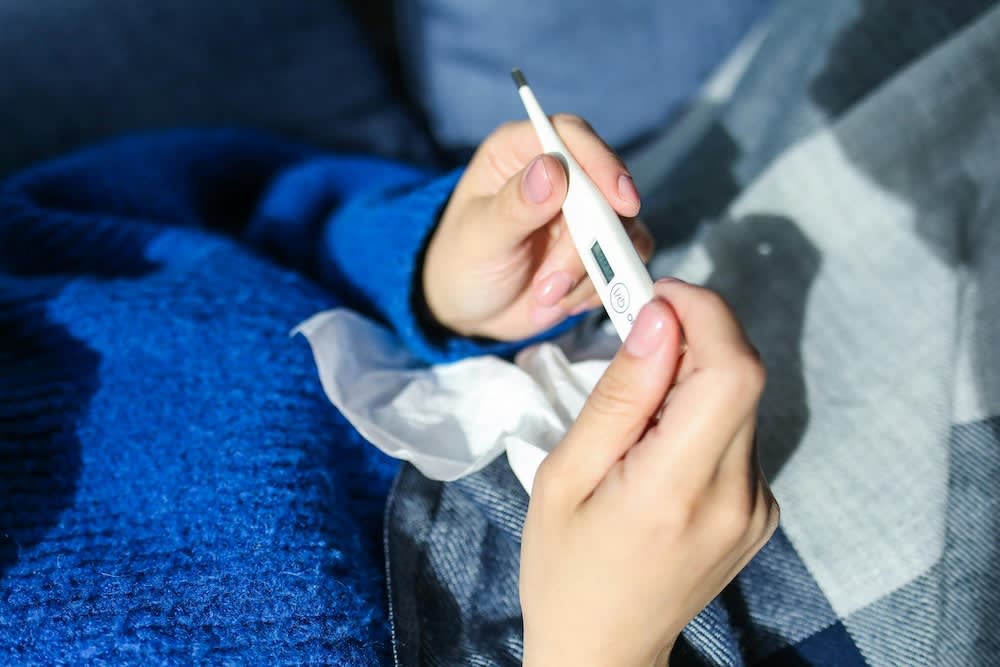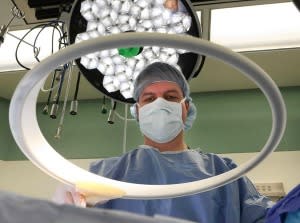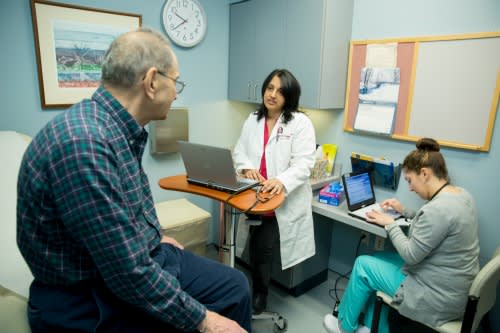Radiofrequency Ablation (RFA): New Thyroid Nodule Treatment Now Available at Stamford Health
Published: April 29, 2025l
Nearly 50% of the adult population has one or more thyroid nodules, which are abnormal growths of thyroid cells that form lumps within the thyroid gland. These nodules can lead to uncomfortable symptoms and possibly surgery to address. Today, there is a new, minimally invasive treatment to address this issue – and it’s now being offered at Stamford Health.
What are thyroid nodules and their symptoms?
Most thyroid nodules are benign – but they can be bothersome. Some people have trouble swallowing, eating, or feel a choking sensation when lying flat. Others may experience shortness of breath when lying flat. If the nodule is sizeable, it can alter one’s appearance.
Thyroid nodules are more common in women than men, and they’re more frequently diagnosed in people ages 50+.
Diagnosing thyroid nodules
As an endocrine surgeon, most of my patients are first evaluated and diagnosed with benign thyroid nodules by a primary care physician or an endocrinologist. An endocrinologist would complete a full workup (including ultrasound and bloodwork) to determine if a nodule is benign or malignant.
When a nodule is determined to be benign, I’ll work with a patient to discuss treatment options. I like to start with an in-depth conversation to determine how severe their symptoms are, and how visible the thyroid nodule is. Next, we’ll discuss treatments.
There is a newer, minimally invasive way to treat benign nodules today – and I perform this procedure at Stamford Health. It’s called radiofrequency ablation, which is a technology used for other tumors and has expanded to treating thyroid disease in the United States since 2019.
What is radiofrequency ablation (RFA) and how is it used to treat thyroid nodules?
The goal of radiofrequency ablation is to shrink thyroid nodules, that are large or causing symptoms, without undergoing surgery. Using a guided ultrasound, I use a heated electrode to treat the nodule with radiofrequency. This burns the cells down so that they shrink, reducing the size of the nodule and hopefully decreasing related symptoms.
This approach doesn’t lead to visible scarring and preserves thyroid function. The recovery time is short – I recommend about a day to recover. There is some soreness and swelling, but most patients tolerate it well with over-the-counter pain relievers.
How effective is RFA in treating thyroid nodules?
Data has shown that patients typically experience a 60-80% decrease in nodule size up to six months to a year following the procedure.
After the procedure, a patient will need to have frequent ultrasounds (at one-month, three-month, six-month, and one-year post procedure) to assess the success of the procedure. If the patient does not experience improvement in symptoms or a patient experiences regrowth, we could offer a second ablation. Surgery is always an option and possibility for patients, but we are delighted to offer a minimally invasive approach to patients who are appropriate candidates.
Most of my patients are very happy with the results of this procedure – and it is now covered by most major insurances. I’m thrilled to be able to offer it to our Stamford Health patients.
What are thyroid nodules and their symptoms?
Most thyroid nodules are benign – but they can be bothersome. Some people have trouble swallowing, eating, or feel a choking sensation when lying flat. Others may experience shortness of breath when lying flat. If the nodule is sizeable, it can alter one’s appearance.
Thyroid nodules are more common in women than men, and they’re more frequently diagnosed in people ages 50+.
Diagnosing thyroid nodules
As an endocrine surgeon, most of my patients are first evaluated and diagnosed with benign thyroid nodules by a primary care physician or an endocrinologist. An endocrinologist would complete a full workup (including ultrasound and bloodwork) to determine if a nodule is benign or malignant.
When a nodule is determined to be benign, I’ll work with a patient to discuss treatment options. I like to start with an in-depth conversation to determine how severe their symptoms are, and how visible the thyroid nodule is. Next, we’ll discuss treatments.
There is a newer, minimally invasive way to treat benign nodules today – and I perform this procedure at Stamford Health. It’s called radiofrequency ablation, which is a technology used for other tumors and has expanded to treating thyroid disease in the United States since 2019.
What is radiofrequency ablation (RFA) and how is it used to treat thyroid nodules?
The goal of radiofrequency ablation is to shrink thyroid nodules, that are large or causing symptoms, without undergoing surgery. Using a guided ultrasound, I use a heated electrode to treat the nodule with radiofrequency. This burns the cells down so that they shrink, reducing the size of the nodule and hopefully decreasing related symptoms.
This approach doesn’t lead to visible scarring and preserves thyroid function. The recovery time is short – I recommend about a day to recover. There is some soreness and swelling, but most patients tolerate it well with over-the-counter pain relievers.
How effective is RFA in treating thyroid nodules?
Data has shown that patients typically experience a 60-80% decrease in nodule size up to six months to a year following the procedure.
After the procedure, a patient will need to have frequent ultrasounds (at one-month, three-month, six-month, and one-year post procedure) to assess the success of the procedure. If the patient does not experience improvement in symptoms or a patient experiences regrowth, we could offer a second ablation. Surgery is always an option and possibility for patients, but we are delighted to offer a minimally invasive approach to patients who are appropriate candidates.
Most of my patients are very happy with the results of this procedure – and it is now covered by most major insurances. I’m thrilled to be able to offer it to our Stamford Health patients.
More Blogs Like This
May 11, 2017
































)














)




